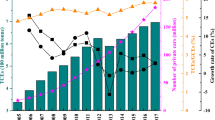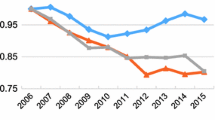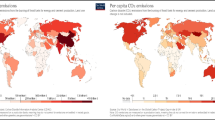Abstract
Rather than relying on traditional factors, low-carbon transportation should be developed by paying more attention to innovation. By constructing an extended stochastic frontier production function, this study explores the threshold effect of technological progress bias on CO2 emission in the transportation sector in eight different regions of China. It is found as the technological progress bias crosses the threshold, the impact of technological progress bias on transportation CO2 emission changes from positive to negative in Northeast China, the midstream of the Yellow River, East China, the Southeast Coast, the midstream of the Yangtze River and the Northwest region. In Northeast China, the coefficient changes from 0.121 to −0.168. In the middle reaches of the Yellow River, the coefficient changes from 0.528 to −0.0468. In East China, the coefficient changes from 0.495 to −0.325. In the Southeast Coast, the coefficient changes from 0.112 to −0.757. In the middle reaches of the Yangtze River, the coefficient changes from 0.518 to −0.177. In Southwest China, the coefficient changes from 0.293 to −0.014. In Northwest China, the coefficient changes from 1.021 to −1.436. In North China, when the technological progress bias exceeds the threshold, the biased technological progress still promotes CO2 emission. The coefficient changes from 0.157 to 0.406. The governments should continue to encourage the transformation of energy technologies from non-renewable energy to renewable energy through differentiated policies.












Similar content being viewed by others
References
Aghion, P. (2016). Carbon taxes, path dependency, and directed technical change: Evidence from the auto industry. Journal of Political Economy, 124(1), 1–51.
Acemoglu, D. (2002). Directed technical change. Review of Economic Studies, 69(4), 781–809.
Acemoglu, D. (2003). Labor- and capital-augmenting technical change. Journal of the European Economic Association, 1(1), 1–37.
Acemoglu, D., & Aghion, P. (2009). The environment and directed technical change. The National Bureau of Economic Research, 10, 116–131.
Antonelli, C. (2016). Technological congruence and the economic complexity of technological change. Structural Change and Economic Dynamics, 38, 15–24.
Acemoglu, D. P., & Aghion, L. (2012). The environment and directed technical change. American Economic Review, 102(1), 131–166.
Andress, D. (2012). Status of advanced light-duty transportation technologies in the US. Energy Policy, 41, 348–364.
Arrow, K., Chenery, H. B., Minhas, B. S., & Solow, R. M. (1961). Capital labor substitution and economic efficiency. Review of Economics and Statistics, 43(3), 225–250.
Bai, X., Zhang, X. L., Li, W., & Tang, Y. (2019). The impact of climate change on the sustainable development of regional economy. Journal of Cleaner Production, 233, 1387–1395.
Binswanger, H. P. (1974). The measurement of technical change biases with many factors of production. American Economic Review, 64(6), 964–976.
Bristow, D. N. (2013). Maximizing the use of energy in cities using an open systems network approach. Ecological Modelling, 250(10), 155–164.
Chen, P., & Yu, M. M. (2014). Total factor productivity growth and directions of technical change bias: Evidence from 99 OECD and Non-OECD Countries. Annals of Operations Research, 214(1), 143–165.
Chen, Y. F., & Liu, Y. N. (2021). How biased technological progress sustainably improve the energy efficiency: An empirical research of manufacturing industry in China. Energy, 230, 120823.
Cui, Q., & Li, Y. (2015). An empirical study on the influencing factors of transportation carbon efficiency: Evidences from fifteen countries. Applied Energy, 141(1), 209–217.
Dong, Y. X. (2019). Does FDI have energy-saving spillover effect in China? A perspective of energy biased technical change. Journal of Cleaner Production, 17302, 1.
Jing, X. I. (2019). Which kind of directed technical change does China’s economy have? From the perspective of energy-saving and low-carbon. Journal of Cleaner Production, 233(10), 160–168.
Hansen, B. E. (1999). Threshold effects in non-dynamic panels: Estimation, testing, and inference. Journal of Econometrica, 93(2), 345–368.
Hou, Z., & Catarina, R.-P. (2021). Does directed technological change favor energy? Firm-Level Evidence from Portugal. Energy Economics, 98, 105248.
Gibbons, S., & Lyytikainen, T. (2019). New road infrastructure: The effects on firms. Journal of Urban Economics, 110, 35–50.
Kha, B. (2020). How to accelerate green technology diffusion? Directed technological change in the presence of coevolving absorptive capacity. Energy Economics, 85, 104565.
Kang, Z. Y. (2018). The path of technological progress for China’s low-carbon development: Evidence from three urban agglomerations. Journal of Cleaner Production, 178(1), 644–654.
Kivyiro, P., & Arminen, H. (2014). Carbon dioxide emissions, energy consumption, economic growth, and foreign direct investment: Causality analysis for Sub-Saharan Africa. Energy, 74(5), 595–606.
Li, T., Pan, S., & Zou, H. (2015). Directed technological change: A knowledge-based model. Macroeconomic Dynamics, 19(1), 1–12.
Li, K., & Yan, Y. X. (2021). Carbon-abatement policies, investment preferences, and directed technological change: Evidence from China. Technological Forecasting and Social Change, 172, 121015.
Liao, M. L. (2020). The ‘double-edged effect’ of progress in energy-biased technology on energy efficiency: A comparison between the manufacturing sector of China and Japan. Journal of Environmental Management, 270(2), 110–124.
Liao, M., Ren, Y., & Zhang, X. (2018). Energy biased technical progress and energy efficiency: An empirical analysis of 27 subdivided manufacturing industries in China. Public Finance Review, 2, 122–123.
Lin, B. Q., & Fei, R. L. (2015). Analyzing inter-factor substitution and technical progress in the Chinese agricultural sector. European Journal of Agronomy, 66, 54–61.
Lin, B. Q., & Long, H. Y. (2014). How to promote energy conservation in China’s chemical industry. Energy Policy, 73, 728–737.
Lin, B. Q., & Ahmad, I. (2015). Technical change, inter-factor and inter-fuel substitution possibilities in Pakistan: A trans-log production function approach. Journal of Cleaner Production, 126(3), 537–549.
Lin, B. Q., & Chen, X. (2020). How technological progress affects input substitution and energy efficiency in China: A case of the non-ferrous metals industry. Energy, 206(1), 118152.
Lin, H., Du, K., & Li, J. (2019). An improved approach to estimate direct rebound effect by incorporating energy efficiency: A revisit of China’s industrial energy demand. Energy Economics, 80(5), 720–730.
Lyu, X., & Ke, H. (2022). Dynamic threshold effect of directed technical change suppress on urban carbon footprint in China. International Journal of Environmental Research and Public Health, 19(9), 5151.
Okushima, S., & Tamura, M. (2009). A double calibration approach to the estimation of technological change. Journal of Policy Modeling, 31(1), 119–125.
Ouyang, X. L., Zhuang, W. X., & Du, G. (2018). Output elasticities and inter-factor substitution: Empirical evidence from the transportation sector of Shanghai. Journal of Cleaner Production, 202(10), 969–979.
Pietzcker, R. (2014). Long-term transport energy demand and climate policy: Alternative visions on transport decarbonization in energy economy models. Energy, 64(1), 95–108.
Peng, J. C. (2019). Energy industry investment influences total factor productivity of energy exploitation: A biased technical change analysis. Journal of Cleaner Production, 237(1), 117847.
Qian, J. (2020). Research on threshold effect of energy saving oriented technological progress on industrial energy saving and emission reduction. Scientific Research Management, 41(1), 223–232.
Smyth, R., Narayan, P. K., & Shi, H. L. (2011). Substitution between energy and classical factor inputs in the Chinese steel sector. Applied Energy, 88(1), 361–367.
Sun, C., & Ouyang, X. (2016). Price and expenditure elasticities of residential energy demand during urbanization: An empirical analysis based on the household-level survey data in China. Energy, 88, 56–63.
Tan, F. F., & Yang, S. S. (2022). The impact of urbanization on carbon emissions: Both from heterogeneity and mechanism test. Environment, Development and Sustainability, 64, 1–17.
Walheer, B. (2018). Labour productivity growth and energy in Europe: A production-frontier approach. Energy, 152(3), 129–143.
Wang, C., & Liao, H. (2018). The fluctuations of China’s energy intensity: Biased technical change. Applied Energy, 135(3), 407–414.
Wang, X., & Lin, B. (2017). Factor and fuel substitution in China’s iron & steel industry: Evidence and policy implications. Journal of Cleaner Production, 141, 751–759.
Welsch, H., & Ochsen, C. (2005). The determinants of aggregate energy use in west Germany: Factor substitution, technological change and trade. Energy Economics, 27(1), 93–111.
Wu, C. Q., & Du, Y. (2018). Research on the impact of biased technological progress on total factor energy efficiency in the Yangtze River Economic Belt. China Soft Science, 17(3), 110–119.
Yan, Z. N., & Ouyang, X. L. (2019). Economy-wide estimates of energy rebound effect: Evidence from China’s provinces. Energy Economics, 83(9), 389–401.
Yang, L., Wang, J. M., & Shi, J. (2017). Can China meet its 2020 economic growth and carbon emissions reduction targets? Journal of Cleaner Production, 142(2), 993–1001.
Yang, B., & Liu, B. Z. (2022). The impact of the embedded global value chain position on energy-biased technology progress: Evidence from Chinas manufacturing. Technology in Society, 71, 102065.
Yang, Z. B., & Hao, C. Y. (2022). Appropriate technology and energy security: From the perspective of biased technological change. Technological Forecasting and Social Change, 177, 121530.
Zha, D. L. (2017). Energy-biased technical change in the Chinese industrial sector with CES production functions. Energy, 33(8), 11875.
Zhang, Y. X. (2017). Echnological progress bias, property right structure and regional energy efficiency in China. Quantitative and Technical Economics Research, 34(8), 2–88.
Zheng, Y., Xiao, J., Huang, F. et al. (2022). How do resource dependence and technological progress affect carbon emissions reduction effect of industrial structure transformation? Empirical research based on the rebound effect in China. Environmental Science Pollution Research, 5, 1–16.
Zhou, X. X., & Pan, Z. X. (2020). Directed technological progress driven by diversified industrial structural change. Structural Change and Economic Dynamics, 54, 112–129.
Acknowledgements
This study was funded by Ministry of Education in China Project of Humanities and Social Sciences (22YJC630184);
Author information
Authors and Affiliations
Contributions
XY was involved in conceptualization, methodology, software, validation, formal analysis, investigation; ZZJ helped in resources, data curation, writing—original draft preparation, writing—review and editing, visualization. All authors have read and agreed to the published version of the manuscript.
Corresponding author
Ethics declarations
Conflict of interest
The authors declare no conflict of interest.
Additional information
Publisher's Note
Springer Nature remains neutral with regard to jurisdictional claims in published maps and institutional affiliations.
Rights and permissions
Springer Nature or its licensor (e.g. a society or other partner) holds exclusive rights to this article under a publishing agreement with the author(s) or other rightsholder(s); author self-archiving of the accepted manuscript version of this article is solely governed by the terms of such publishing agreement and applicable law.
About this article
Cite this article
Yang, X., Jia, Z. & Yang, Z. Does biased technological progress facilitate the reduction of transportation carbon emissions? A threshold-based perspective. Environ Dev Sustain 26, 4269–4292 (2024). https://doi.org/10.1007/s10668-022-02883-6
Received:
Accepted:
Published:
Issue Date:
DOI: https://doi.org/10.1007/s10668-022-02883-6




